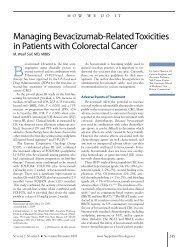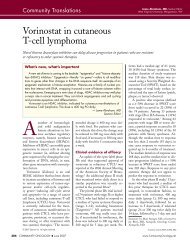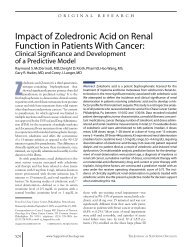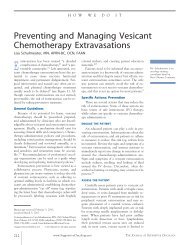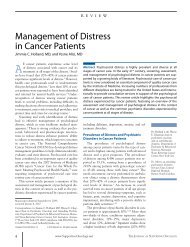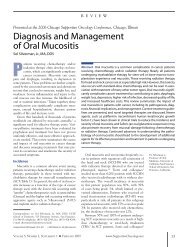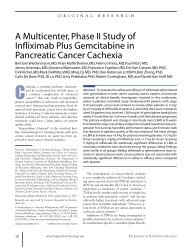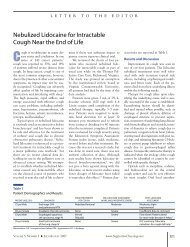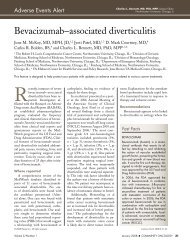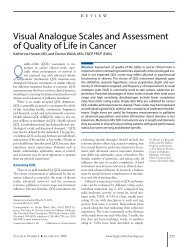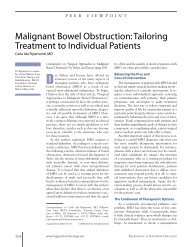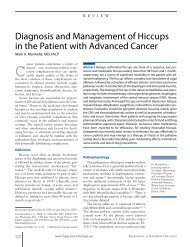Volume 9 Number 3 March 2012 - Oncology Practice Digital Network
Volume 9 Number 3 March 2012 - Oncology Practice Digital Network
Volume 9 Number 3 March 2012 - Oncology Practice Digital Network
You also want an ePaper? Increase the reach of your titles
YUMPU automatically turns print PDFs into web optimized ePapers that Google loves.
Features<br />
Practical Biostatistics<br />
Moving up in the world: screening for<br />
lung cancer<br />
David L. Streiner, PhD, CPsych, 1,2 and Geoffrey R. Norman, PhD 2<br />
1 Departments of Psychiatry, University of Toronto, Toronto, Ontario, Canada; 2 Clinical Epidemiology and Biostatistics,<br />
McMaster University, Hamilton, Ontario, Canada<br />
Commun Oncol <strong>2012</strong>;9:110-111 © <strong>2012</strong> Elsevier Inc. All rights reserved.<br />
doi:10.1016/j.cmonc.<strong>2012</strong>.02.011<br />
In one of our previous articles, we discussed a<br />
study of screening for prostate cancer. 1 Now<br />
we’re going to move up a bit, at least anatomically,<br />
and discuss a study of screening for lung<br />
cancer. 2 We have previously defined ourselves as<br />
curmudgeons and skeptics; to those self-descriptions<br />
we now add a new term, “chutzpahniks.” For<br />
those of you who may be unfamiliar with that<br />
Yiddish term, it means people who have chutzpah,<br />
which was defined by Leo Rosten 3 as: “that quality<br />
enshrined in a man who, having killed his mother<br />
and father, throws himself on the mercy of the<br />
court because he is an orphan.” Our chutzpah<br />
stems from the fact that we are criticizing the<br />
results of a study that was published in the New<br />
England Journal of Medicine and highly praised in<br />
an editorial in that journal. 4 If we had less chutzpah,<br />
we wouldn’t contemplate such a critique, but<br />
then again, if we had less chutzpah, we—a clinical<br />
psychologist and a nuclear physicist—wouldn’t be<br />
writing articles in a cancer journal. So, on to the<br />
study.<br />
Participants were people between the ages of<br />
55 and 74 years who were currently or had previously<br />
been heavy smokers (at least 30 pack years),<br />
and were randomly assigned to be screened with<br />
either low-dose CT (26,722 participants) or chest<br />
radiography (26,732). They were screened at baseline<br />
and then 1 and 2 years later; those in whom<br />
lung cancer was diagnosed were not offered subsequent<br />
screening. What brought joy to the hearts<br />
of the researchers and the editorialist was the fact<br />
that there were 309 deaths from lung cancer per<br />
100,000 person-years in the radiography group<br />
and only 247 deaths per 100,000 person-years in<br />
the CT group, representing a reduction of 20.0%.<br />
All-cause mortality was also reduced by 6.7% in<br />
the CT group. From a methodological point of<br />
view, it would be hard to fault this study. It involved<br />
over 53,000 patients enrolled in 33 sites,<br />
with adherence rates of 95% in the low-dose CT<br />
group and 93% in the radiography group over the<br />
three rounds.<br />
Given these impressive figures, what leads to<br />
our curmudgeonly, skeptical, and chutzpahdikeh<br />
feelings? Actually, a number of things. The first is<br />
the sample size. As we’ve mentioned in a previous<br />
article, 5 sample size is much like the magnification<br />
in a microscope; the smaller the phenomenon<br />
you’re looking at, the larger the sample size has to<br />
be. We have also said that you should be suspicious<br />
of relative statistics—the odds ratio and relative<br />
risk 6 (we just love it when we can quote<br />
ourselves). Both factors come into play here. Our<br />
feeling is that if you need over 50,000 patients,<br />
followed for 3 years, to demonstrate something,<br />
that something must be very small. That’s masked<br />
by presenting the results as a relative reduction in<br />
mortality. To the authors’ credit, they also give us<br />
the actual numbers, so we can see how large—or<br />
small—the effect actually is. Using their figures,<br />
the absolute reduction in deaths was (309 – 247)<br />
per 100,000 patient years, or 1 additional year of<br />
life for 62 people for every 100,000 screened. We<br />
leave it to you to determine if that’s a lot or a little.<br />
Ceteris paribus (that’s Latin for “All other things<br />
being equal,” and used here merely to be a bit<br />
pretentious), we should switch immediately from<br />
radiography to low-dose CT scans. But, all things<br />
being equal, all things are never equal. At least two<br />
questions need to be raised.<br />
The first is economic; how much more will it<br />
cost to replace all the X-rays with CT scans, and<br />
all those X-ray machines with CT scanners?<br />
There is a concept from economics called “opportunity<br />
costs;” that is, what opportunities are we<br />
foregoing by spending money on a given program?<br />
Money for health care is finite, as we are constantly<br />
reminded, so every extra dollar that is spent<br />
for CT scans rather than X-rays means that one<br />
110 COMMUNITY ONCOLOGY <strong>March</strong> <strong>2012</strong> www.Community<strong>Oncology</strong>.net



